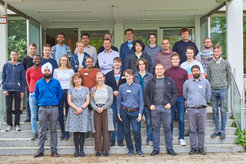9th Runaway Electron Modelling Meeting shows the increasing importance of modelling for ITER
After the 2021 meeting was cancelled due to the Corona pandemic, many of the international experts met in person for the first time in two years.
At the event from May 2nd to 6th 2022 at the Max Planck Institute for Plasma Physics (IPP) in Garching, around 50 scientists discussed current results.

Relativistic electrons, so-called runaway electrons (REs), are considered one of the major challenges on the way to fusion power plants. They could severely damage future plants – for example, the international joint experiment ITER currently being built in Cadarache in southern France. For this reason, researchers around the world are looking for ways to suppress the formation of REs. In the Runaway Electron Modelling Meetings, which started in 2013 at Sweden's Chalmers University in Gothenburg, theoretical physicists present approaches for modelling of the RE phenomenon and its suppression every year.
This year's meeting in Garching was the ninth of its kind. Last year, the event had been cancelled due to the Corona pandemic. This time, there was a hybrid meeting - with only about a quarter of the participants attending online. Most came to Garching in person. "We are pleased that more experimental physicists attend each time," says IPP researcher Dr Gergely Papp from the meeting's organising team. "This shows us how important modelling has become for planning experiments."
Relativistic electrons are produced in tokamak-type fusion devices during plasma disruptions. During such an event, the energy confinement of the plasma gets lost on a short time scale such that the temperature of the plasma drops by orders of magnitude. As a result of the increasing resistivity and the large plasma current, a strong toroidal electric field arises that can accelerate electrons to relativistic velocities. Via collisions, the number of such runaway electrons can increase exponentially until the whole plasma current is carried by REs. When such an RE beam is eventually lost in a future reactor like ITER, it could lead to massive loads onto material components and deep melting of the walls such that avoidance and mitigation is of high priority.
The main mitigation scheme envisaged for ITER is the injection of large quantities of material (a mix of hydrogen and neon) into the device via so-called Shattered Pellet Injection (SPI). At the ASDEX Upgrade tokamak facility at the Max Planck Institute for Plasma Physics in Garching, a new shattered pellet injection system has recently been installed with ITER and is exploited together with ITER and EUROfusion.
"Many participants told me that a highlight of our meeting was the tour of the Shattered Pellet Injector and the presentation of the first measurement results," reports IPP physicist Dr Matthias Hölzl, who co-organised the event.
Several presentations dealt specifically with SPIs. Others showed significant progress in creating validated models with different complexity (in particular lower dimensional kinetic and hybrid 3D magnetohydrodynamic models).
